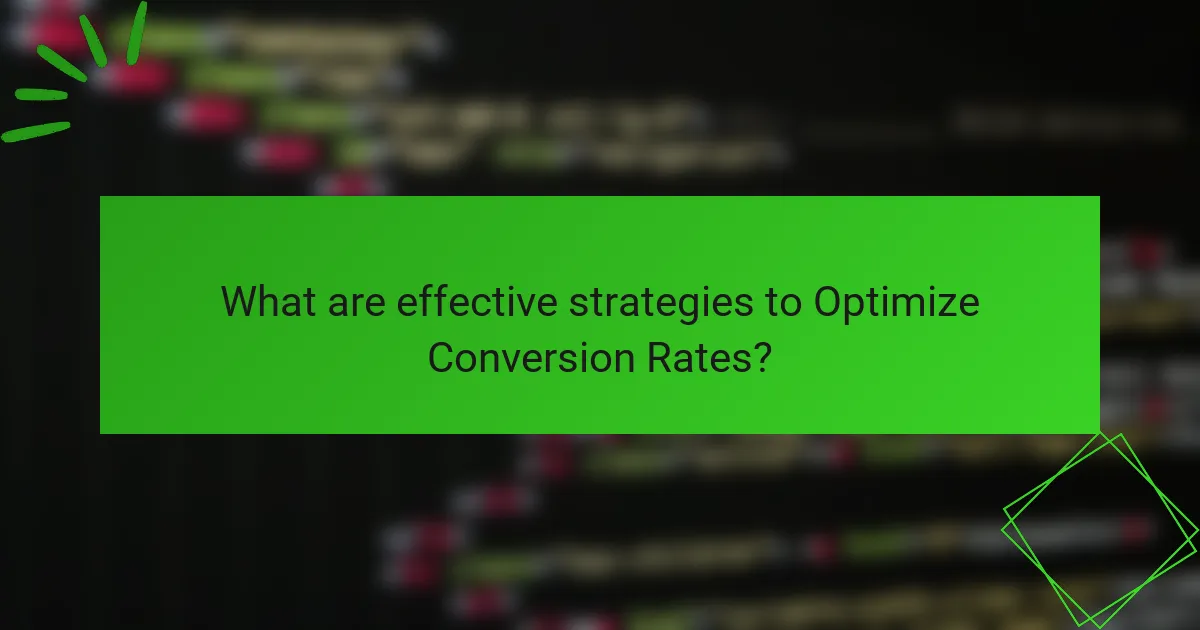Understanding and optimizing conversion rates is vital for e-commerce success, as it measures the percentage of visitors who take desired actions, like making a purchase. By focusing on enhancing user experience and employing strategies such as personalization and social proof, businesses can significantly boost their conversion rates. Utilizing built-in tools from e-commerce platforms further aids in tracking performance and identifying areas for improvement.

How to Measure Conversion Rates in E-commerce?
Measuring conversion rates in e-commerce involves calculating the percentage of visitors who complete a desired action, such as making a purchase. This metric is crucial for assessing the effectiveness of your online store and identifying areas for improvement.
Key metrics for conversion rate measurement
To measure conversion rates effectively, focus on key metrics such as the overall conversion rate, cart abandonment rate, and average order value. The overall conversion rate is calculated by dividing the number of conversions by the total number of visitors, while the cart abandonment rate indicates how many users leave items in their cart without completing the purchase.
Additionally, tracking metrics like customer acquisition cost and return on ad spend can provide insights into the financial efficiency of your marketing efforts. Aim for an overall conversion rate in the low single digits, as this is typical for many e-commerce sites.
Tools for tracking conversion rates
Several tools can help you track conversion rates effectively. Google Analytics is a widely used platform that offers robust tracking capabilities, allowing you to monitor user behavior and conversion paths. Other options include specialized e-commerce analytics tools like Shopify Analytics or WooCommerce Analytics, which provide tailored insights for online stores.
Utilizing heat mapping tools such as Hotjar or Crazy Egg can also enhance your understanding of user interactions on your site, helping you identify areas that may need optimization. Choose tools that integrate seamlessly with your existing systems for the best results.
Importance of A/B testing
A/B testing is essential for optimizing conversion rates, as it allows you to compare two versions of a webpage to determine which one performs better. By testing different elements, such as headlines, images, or call-to-action buttons, you can make data-driven decisions that enhance user experience and increase conversions.
Implement A/B tests regularly, focusing on one variable at a time to isolate its impact. Aim for a statistically significant sample size to ensure reliable results. Avoid common pitfalls like testing too many changes at once, which can lead to inconclusive outcomes.

What are effective strategies to Optimize Conversion Rates?
Effective strategies to optimize conversion rates focus on enhancing user experience, personalizing interactions, and leveraging social proof. Implementing these strategies can significantly improve the likelihood of visitors completing desired actions, such as making a purchase or signing up for a newsletter.
User experience enhancements
Improving user experience (UX) is crucial for boosting conversion rates. This can include optimizing website speed, simplifying navigation, and ensuring mobile responsiveness. A well-designed site that loads quickly and is easy to navigate can reduce bounce rates and encourage users to explore further.
Consider conducting usability testing to identify pain points in the user journey. Tools like heatmaps can reveal where users click most often, helping you make informed adjustments. Aim for a seamless checkout process, as a complicated or lengthy process can deter potential customers.
Personalization techniques
Personalization techniques involve tailoring content and offers to individual users based on their behavior and preferences. This can be achieved through targeted email campaigns, product recommendations, and customized landing pages. For instance, showing users items related to their previous searches can enhance their shopping experience.
Utilizing data analytics can help you understand customer segments and their specific needs. Implementing A/B testing can also guide you in determining which personalized approaches yield the best conversion rates. Remember to respect user privacy and comply with regulations like GDPR when collecting and using personal data.
Utilizing social proof
Social proof is a powerful tool for increasing conversion rates by showcasing the experiences of previous customers. This can include customer reviews, testimonials, and case studies that highlight the value of your products or services. Displaying ratings and feedback prominently on product pages can build trust and credibility.
Consider integrating user-generated content, such as photos or videos from satisfied customers, into your marketing strategy. This not only enhances authenticity but also encourages potential buyers to envision themselves using your products. Keep in mind that a mix of positive and constructive feedback can provide a balanced view that resonates with potential customers.

Which E-commerce Platforms Offer Built-in Conversion Rate Tools?
Many e-commerce platforms provide built-in tools for tracking and optimizing conversion rates, which are essential for measuring sales performance. These tools help businesses analyze customer behavior, identify bottlenecks, and improve overall sales effectiveness.
Shopify conversion tracking features
Shopify offers robust conversion tracking features that allow merchants to monitor their sales funnel effectively. Users can access analytics dashboards that display key metrics, including conversion rates, average order value, and customer acquisition costs.
Shopify integrates with Google Analytics and provides its own reports, enabling users to track conversions from various marketing channels. Merchants can set up goals and funnels to visualize the customer journey, helping them identify areas for improvement.
WooCommerce analytics tools
WooCommerce, a popular WordPress plugin, includes built-in analytics tools that help track conversion rates and sales performance. Users can view detailed reports on orders, customers, and product performance directly from their WordPress dashboard.
Additionally, WooCommerce allows integration with Google Analytics for more advanced tracking capabilities. Merchants can utilize plugins to enhance their reporting, such as tracking abandoned carts or analyzing customer behavior on their site.
BigCommerce optimization options
BigCommerce provides various optimization options for tracking conversion rates, including customizable reporting tools. Users can access real-time analytics that show how different products and marketing campaigns perform in terms of conversions.
BigCommerce also supports A/B testing, allowing merchants to experiment with different site elements to see which versions yield higher conversion rates. This feature is crucial for optimizing product pages and checkout processes to maximize sales.

What are the Common Conversion Rate Challenges in Australia?
In Australia, online retailers face several conversion rate challenges that can hinder e-commerce success. Understanding these issues is crucial for optimizing sales and improving customer experience.
High cart abandonment rates
High cart abandonment rates are a significant challenge for Australian e-commerce businesses, often exceeding 60%. Factors contributing to this include unexpected shipping costs, complicated checkout processes, and lack of payment options.
To reduce cart abandonment, streamline the checkout process by minimizing steps and offering guest checkout options. Additionally, clearly display shipping costs early in the process to avoid surprises.
Mobile optimization issues
With a large portion of Australian consumers shopping via mobile devices, poor mobile optimization can severely impact conversion rates. Websites that are not mobile-friendly can lead to frustrating experiences, causing potential customers to leave without completing a purchase.
Ensure your website is responsive and loads quickly on mobile devices. Test navigation and checkout processes on various screen sizes to identify and fix usability issues that could deter shoppers.
Trust and security concerns
Trust and security are paramount for Australian consumers when shopping online. Concerns about data privacy and payment security can prevent customers from completing purchases, especially if they perceive a lack of secure payment options.
To build trust, prominently display security badges and offer well-known payment methods like PayPal or Afterpay. Additionally, provide clear information about data protection policies to reassure customers about their privacy.

How to Analyze Conversion Rate Data Effectively?
To analyze conversion rate data effectively, focus on key metrics that reveal user engagement and behavior on your e-commerce site. Understanding these metrics helps identify areas for improvement and optimize the user journey to boost conversions.
Using Google Analytics for insights
Google Analytics is a powerful tool for tracking conversion rates and user interactions on your website. Start by setting up goals that align with your business objectives, such as completed purchases or newsletter sign-ups. This allows you to measure how well your site converts visitors into customers.
Utilize the e-commerce tracking feature to gain insights into sales performance, average order value, and conversion rates by traffic source. Regularly review these metrics to identify trends and adjust your marketing strategies accordingly.
Interpreting user behavior reports
User behavior reports provide valuable insights into how visitors navigate your site, helping you understand their preferences and pain points. Look for metrics such as bounce rate, time on site, and pages per session to gauge user engagement. High bounce rates may indicate issues with your landing pages or content relevance.
Segment your audience to analyze behavior across different demographics or traffic sources. This can reveal which groups convert better and help tailor your marketing efforts. Regularly testing and optimizing based on these insights can lead to significant improvements in your conversion rates.










